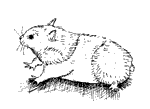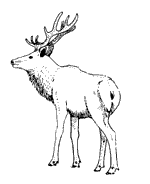|
Books that focus on animal behavior, particularly
regarding their movements and ways of observing, tracking, and
recording them make excellent connections to this GEMS guide.
In the following books, connections are made to real research
conducted by Charles Darwin, James Audubon, and a naturalist studying
wolf behavior. Readers are able to follow the true-life movements
of a snapping turtle’s journey on the Mississippi River with
detailed descriptions and illustrations. In another book, a young
girl takes a hike in search of a mysterious bird, and learns much
about the woodland habitat along the way.
The Beagle and Mr. Flycatcher: A Story
of Charles Darwin
The Black Pearl
A Caribou Alphabet
Chipmunk Song
Darwin and the Voyage of the Beagle
Frogs, Toads, Lizards, and Salamanders
Hatchet
The Island
Minn of the Mississippi
Mrs. Frisby and the Rats of NIMH
Never Cry Wolf
Nicky The Nature Detective
On the Frontier with Mr. Audubon
One Day in the Tropical Rain Forest
One Day in the Woods
Owl Moon
The Roadside
The Song in the Walnut Grove
The Beagle and Mr. Flycatcher:
A Story of Charles Darwin
by Robert Quackenbush
Prentice Hall, Englewood Cliffs, New Jersey. 1983
Grades: 4–8
This biography tells how Charles Darwin began his career as an
unpaid naturalist aboard the brig H.M.S. Beagle on a five-year
voyage around South America and began to formulate his revolutionary
theory of evolution. There are brief descriptions of Darwin’s
specimen collecting (cuttlefish, shellfish fossils, sloth jawbone),
scientific observation (finches, an ostrich skeleton) and of a
subsequent eight-year study of barnacles. Although the illustrations
are in a cartoon style and the writing uses a humorous approach,
quite a bit of information is conveyed. Might be followed up with
the fictional diary of a cabin boy in Darwin and the Voyage of
the Beagle.
Return to titles list.
The Black Pearl
by Scott O’Dell; illustrated by Milton Johnson
Houghton Mifflin, Boston. 1967
Grades: 5–12
Ramon’s dream is to dive for pearls in the waters of
Baja, California, and to one day find the great pearl—the
magnificent Pearl of Heaven. But to do so, Ramon must confront
the giant manta ray Diablo who guards the pearl. An absorbing
story of a young boy’s quest for the pearl and his manhood,
with the Vermilion Sea as the beautiful backdrop. The movements
and interaction of underwater animals are wonderfully described.
Return to titles list.
A Caribou Alphabet
by Mary Beth Owens
Dog Ear Press, Brunswick, Maine. 1988
Farrar, Straus & Giroux, New York. 1990
Grades: K–5
An alphabet book depicting the characteristics and ways of
caribou. While at first glance, this book may seem a primary-level
“A, B, C” book, it includes a compendium of information
about caribou, including intricacies of their behavior, habitat
requirements, and physical features.
Return to titles list.
Chipmunk Song
by Joanne Ryder
E.P. Dutton, New York. 1987
Grades: K–5
A lyrical description of a chipmunk as it goes about its activities
in late summer, prepares for winter, and settles in until spring.
You are put in the place of a chipmunk—through food gathering,
hiding from predators, hibernation, and more. Detailed illustrations
show everything from roots invading the chipmunk’s hole,
to underground stashes of acorns.
Return to titles list.
Darwin and the Voyage of the Beagle
by Felicia Law; illustrated by Judy Brook
Andre Deutsch, Great Britain. 1985
(Distributed by E.P. Dutton, New York)
Grades: 4–8
A cabin boy goes along on Charles Darwin’s five-year
voyage. He assists Darwin with his collection of insect, bird,
and marine life specimens all the while learning about their habits
and habitats. On one occasion they return with 68 different species
of one beetle. They collect fossils in the Andes, straddle Galapagos
tortoises, discover the skeleton of the Megatherium, and get to
know Fuegan natives. The format is oversized, with many drawings,
charts and maps.
Return to titles list.
Frogs, Toads, Lizards, and Salamanders
by Nancy W. Parker and Joan R. Wright; illustrated
by Nancy W. Parker
Greenwillow, New York. 1990
Grades: 3–6
The physical characteristics, habits, and environment of 16
creatures are encapsulated in rhyming couplets, text, and anatomical
drawings, plus glossaries, range maps, and a scientific classification
chart. A great deal of information is presented, the rhymes are
engaging and humorous, and the visual presentation terrific. “A
slimy Two-toed Amphiuma/terrified Grant’s aunt from Yuma”
(she was picking flowers from a drainage ditch).
Return to titles list.
Hatchet
by Gary Paulsen
Bradbury Press/Macmillan, New York. 1987
Puffin/Viking Penguin, New York. 1988
Grades: 6–12
After the pilot of a single-engine plane dies of a heart attack,
the sole passenger, 13-year-old Brian, is left to survive alone
in the Canadian wilderness. He gets the worst of encounters with
a porcupine, a skunk, and a moose. He slowly learns how to provide
fire, shelter, and food for himself. His motivation for observing
animal, bird, and fish habits is simply to track and hunt them
for food. He makes a spear and bow and arrow and learns to store
and cook food. “It had always been so simple at home. He
would go to the store and get a chicken and it was all cleaned
and neat, no feathers or insides, and his mother would bake it
in the oven.”
Return to titles list.
The Island
by Gary Paulsen
Orchard/Franklin Watts, New York. 1988
Bantam Doubleday Dell, New York. 1990
Grades: 6–12
Wil Neuton seeks solace from family problems on an island
in a lake in Wisconsin. He finds solitude and discovers a new
interest in the bird, fish, and animal life whose behavior he
observes, describes, and paints. A loon and her chicks first attract
his interest, then a blue heron swallowing a frog, ants scavenging
leftovers from a tin can, and a snapping turtle’s bloody
conquest of a sunfish. “I could see the heron, finally, with
every one of his gray blue-feathers shining on the edge of purple,
with his tapered beak and crest and curved-over neck and clean
lines and by not looking at the heron I could see me. At the end,
I could see myself in the heron.”
Return to titles list.
Minn of the Mississippi
by Holling Clancy Holling
Houghton Mifflin, Boston. 1951
Grades: 5–9
The journey of Minn, a snapping turtle, is followed from northern
Minnesota to the bayous of Louisiana. Her adventures with people,
animals, and the changing seasons are vividly described. Wonderful
drawings and maps of her travels accompany the engaging true-life
story on the Mississippi.
Return to titles list.
Mrs. Frisby and the Rats of NIMH
by Robert C. O’Brien; illustrated by Zena Bernstein
Atheneum, New York. 1971
Grades: 4–12
A mother mouse learns that the rat colony near her home is
actually a group of escapees from an NIMH research institute.
These rats, injected with DNA and other substances, have acquired
great intelligence, learned to read and write, and are planning
to develop their own civilization. In addition to offering a great
plot, the book helps us to visualize nature from the scale of
a small animal, to imagine communications between birds and rodents,
to consider the impact of animal experimentation, and to comment
on the technological top-heaviness of modern day human society.
Newbery award winner.
Return to titles list.
Never Cry Wolf
by Farley Mowat
Atlantic Monthly/Little, Brown & Co., New York. 1963
Bantam Books, New York. 1984
Grades: 6–Adult
Wolves are killing too many of the Arctic Caribou, so the
Wildlife Service assigns a naturalist to investigate. Farley Mowat
is dropped alone onto the frozen tundra of Canada’s Keewatin
Barrens to live among the wolf packs to study their ways. His
interactions with the packs, and his growing respect and understanding
for the wild wolf will captivate all readers.
Return to titles list.
Nicky The Nature Detective
by Ulf Svedberg; illustrated by Lena Anderson
R & S Books/Farrar, Straus & Giroux, New York. 1983
Grades: 3–8
Nicky loves to explore the changes in nature. She watches
a red maple tree and all the creatures and plants that live on
or near the tree through the seasons of the year. Her discoveries
lead her to look carefully at the structure of a nesting place,
why birds migrate, who left tracks in the snow, where butterflies
go in the winter, and many many more things. This book is packed
with information.
Return to titles list.
On the Frontier with Mr. Audubon
by Barbara Brenner
Coward, McCann & Geoghegan, New York. 1977
Grades: 6–9
Based on an unedited diary of 1820-26, this fictionalized
journal tells of Joseph Mason, a 13-year-old assistant who really
traveled with John J. Audubon for 18 months. The work gives a
detailed account of their daily life, hunting, drawing birds and
their habitats, a stay at a plantation, and travel by flatboat,
keelboat, and steamer. Black and white illustrations include reproductions
of paintings and drawings by Audubon and other artists of his
day.
Return to titles list.
One Day in the Tropical Rain Forest
by Jean C. George; illustrated by Gary Allen
HarperCollins, New York. 1990
Grades: 4–7
A section of rain forest in Venezuela is scheduled to be bulldozed
as young boy and a scientist seek a new species of butterfly for
a wealthy industrialist who might preserve the forest. As they
travel through the ecosystem rich with plant, insect, and animal
life, everything they see on this one day is logged, beginning
with sunrise at 6:29 a.m. They finally arrive at the top of the
largest tree in the forest and fortuitously capture a specimen
of an unknown butterfly.
Return to titles list.
One Day in the Woods
by Jean C. George; illustrated by Gary Allen
Thomas Y. Crowell, New York. 1988
Grades: 4–7
On a day-long outing in a forest, Rebecca, a “ponytailed
explorer,” searches for the elusive ovenbird. Wonderful detail
on her observation and interaction with the plant and animal life
enhanced by realistic black and white drawings.
Return to titles list.
Owl Moon
by Jane Yolen; illustrated by John Schoenherr
Philomel/Putnam, New York. 1987
Grades: Preschool–5
On a moonlit winter night, a father and daughter go searching
for the elusive Great Horned Owl. The suspense of the hunt, along
with the lyrical language and stunning illustrations of a rural
scene at night make one feel a part of the expedition. They seek
the owl in its habitat, observe its behavior, and imitate its
call.
Return to titles list.
The Roadside
by David Bellamy; illustrated by Jill Dow
Clarkson N. Potter/Crown, New York. 1988
Grades: K–5
The construction of a six-lane highway in a wilderness area
disrupts the balance of nature and forces animals there to struggle
for existence.
Return to titles list.
The Song in the Walnut Grove
by David Kherdian; illustrated by Paul O. Zelinsky
Alfred A. Knopf, New York. 1982
Grades: 4–6
A curious cricket meets a grasshopper. Together they learn
of each other’s daytime and nighttime habits while living
in a herb garden. Their friendship grows as they learn to appreciate
each other’s differences. This story weaves very accurate
accounts of insect behavior and their contributions to the ecology
of Walnut Grove.
Return to titles list.
|
|


